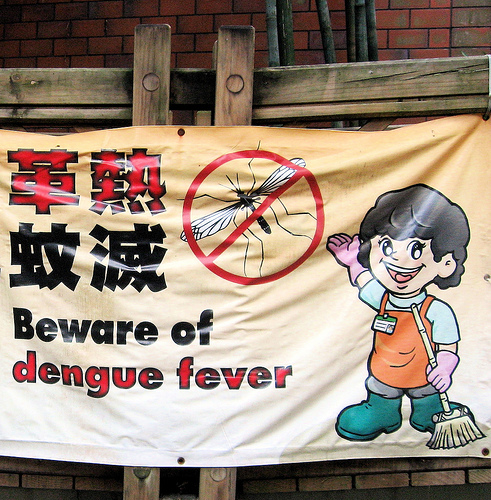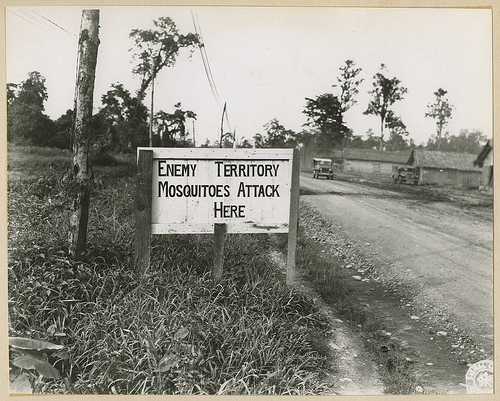Wise travelers know to “get their jabs” before setting sail to some far off place. But why? What exactly are these diseases we’re all getting inoculated against? Will they lead to a grim and grisly death or just a good story to tell the grandkids?
Vagabondish is reader-supported. When you buy through links on our site, we may earn a small affiliate commission. Read our disclosure.
We combed CDC Travel and other health resources to gather a list of diseases and the most common travel illnesses, and all the reasons why you want to avoid them.
The Most Common Travel Illnesses
#1: Cholera
Forgive me for feeling that this disease sounded romantic when Gabriel Garcia Marquez included it in the title of his novel Love in the Time of Cholera — it is actually pretty nasty. You might pick it up in many parts of Africa and Asia, but it can occur anywhere with poor sanitation. You don’t want cholera because you’ll end up with diarrhea, vomiting, and fever, and it has the potential to be fatal, too.
Jabs are all well and good but the usefulness of the cholera vaccine is disputed — some experts say its effectiveness is only 50%. Since you pick up the cholera bacteria from contaminated food and water, you should avoid uncooked food and unbottled water.

© Ross_Angus
#2: Tetanus
While tetanus is the kind of disease that could happen to you anywhere, the highest number of reported incidences are in places like India and countries in central Africa. Tetanus is also called lockjaw for a good reason — it affects your nervous system and makes your muscles spasm and seize up.
But the good news about tetanus is that the vaccine is perfect. As long as you have your booster every ten years. Even in the United States, five people still die every year from tetanus, so it’s worth getting the jab even if you’re not planning to travel soon.
#3: Typhoid
Don’t ask me why, but typhoid has always sounded really dark and tragic to me. What I hadn’t realized is that it’s actually caused by the salmonella bacteria, and is transmitted if you consume food or water that’s been contaminated by the feces of an infected person. Nasty. It’s most commonly contracted in India and parts of Asia, Africa, and South America.
Typhoid is a disease that might hit you suddenly, but then develops slowly — you’ll get a fever, and after a week or so you might become delirious. In the vast majority of cases, it isn’t fatal, and the vaccine is also reasonably effective.

© jurvetson
#4: Dengue Fever
Once you know that dengue fever has been nicknamed break-bone fever or bonecrusher disease, you know it’s something you want to avoid. The initial fever is made worse by a headache, muscle and joint pains along with a really unattractive rash.
Dengue fever is most commonly found in tropical areas and parts of Africa. It’s a bit scarier because it also occurs in more developed parts of the tropics, like Singapore or Taiwan. Mosquitoes spread this disease and there’s no commercial vaccine yet, so use a repellent and nets to avoid getting bitten.
#5: Hepatitis
The various incarnations of hepatitis are running there way through the alphabet, but travelers need to worry most about types A and B.
Hepatitis A is found in developing countries including India, Mexico, Latin America and parts of Africa and is a nasty infection of the liver. Symptoms include fever, nausea and jaundice for a week or up to several months, but it’s rarely fatal, and it is usually picked up from contaminated food and water or close contact with infected people.
Hep A’s big, bad brother Hepatitis B is found in similar regions, plus the Middle East and some Pacific Islands, and can lead to a whole heap of liver damage, cirrhosis of the liver and liver cancer. Fortunately, it’s also harder to catch, as it’s usually transmitted only via blood, shared needles and body fluids. You have to plan ahead if you’re traveling to a Hepatitis B risk area because vaccinations must start over six months before you travel. And this one can kill you.
#6: Malaria
This is one of the trickiest diseases (and one of the most common travel illnesses) to deal with while traveling abroad. Most of the medication needs to be taken before, during, and after your trip, and some of it can have unpleasant side effects. These days, malaria is found in at least a hundred countries — the Center for Disease Control has quite a handy risk map to check your destination.

Malaria Control Sign © otisarchives2
You can catch malaria from a mosquito bite, so covering up against these nasties is a must along with taking medication. Symptoms including a fever and something similar to the flu; it’s not usually fatal, but it can be. Scientists are still working on a vaccine against malaria, and that’s something that would be a big benefit to travels if they figured it out successfully.
#7: Yellow Fever
Another mosquito-borne nasty is yellow fever. It’s among the most common travel illnesses, mostly found in the tropical parts of South America and Sub-Saharan Africa.
Victims usually end up with jaundice, hence “yellow” fever. But while yellow fever can also kill you, it’s easier to prevent because the vaccination is nearly always effective, and only needs to be administered a couple of weeks before you travel.
#8: HIV / AIDS
While definitely not only a travelers’ disease, HIV is becoming a serious issue for travelers in Africa and South East Asia where it’s become scarily prevalent. Yet a lot of carriers don’t realize they have the virus. As a result, many of these people will remain untreated and consequently, die of AIDS.
Fortunately, reducing your risk of contracting HIV as a traveler is mostly a matter of common sense and taking care. Avoid casual sex, use your own, high-quality condoms if you have sex with someone you meet, don’t share needles or syringes or get a tattoo or piercing. Common sense, right?
#9: Japanese Encephalitis
Those mosquitoes are responsible for all manner of unfriendly diseases and Japanese encephalitis is definitely one to avoid. It affects the central nervous system, causing severe flu-like symptoms, and it can be fatal. The vaccine is quite effective, especially if you get the recommended two doses.
And contrary to the suggestion in its name, Japanese encephalitis isn’t limited to Japan at all — it’s most common in agricultural regions of countries like Vietnam, Cambodia, India, Nepal and Malaysia. Again, cover up against mosquitoes if you’re traveling in these areas.
#10: Meningitis
Meningitis is another common travel illness/disease that’s not exclusively the province of travelers or the third world — it can occur, rarely, in Western countries too. However, the “Meningitis Belt” is an area stretching across Africa from Senegal to Ethiopia where it’s relatively common for large outbreaks of meningococcal meningitis to occur.
Meningitis usually comes from contact with, ahem, nose or throat discharges from someone who’s infected. This time you’ll also start with a fever, but usually progress to vomiting, a stiff neck and a bad purple rash. There are vaccinations available (but not against all kinds), or antibiotics can treat it. If you have suspicion of having meningitis, it’s the sort of thing you want to check out immediately — untreated cases are often fatal.
So, there you have it: the most common travel illnesses. If you get your shots before you travel, and you’re relatively careful on the road, the worst case scenario is usually just a minor version of these nasty diseases. But remember, I’m not a doctor, so check with yours before you head off into the danger zone.
For more info on the most common travel illnesses and foreign diseases, check out:


